Golden Touch: How to shoot like Steph
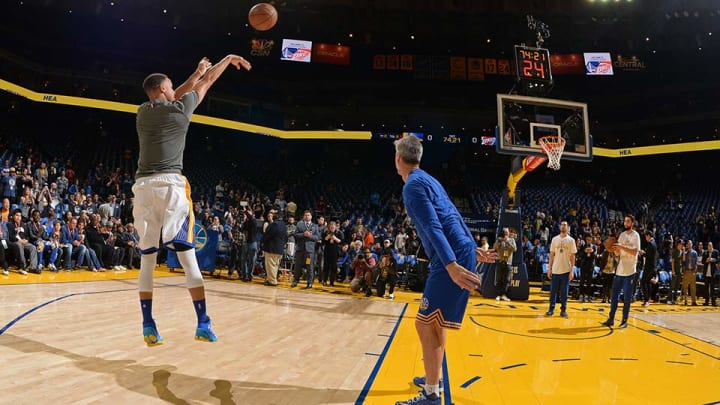
OAKLAND, Calif. — Last week, Warriors assistant coach Bruce Fraser stood below a basket at the Golden State practice facility and engaged in an admittedly ridiculous exercise: explaining how to shoot like Steph Curry.
Ridiculous because, of course, no one can shoot like Steph Curry. The only way to shoot like Steph is to have a father who is one of the best shooters in NBA history, spend your entire life honing your craft and even then, based on Curry family history, you’ve still got only a 50–50 shot. This is not to belittle Seth, who is a fine shooter; it’s just the reality. Rarely have nature and nurture collaborated as enthusiastically as in the case of Steph.
Surely you’re familiar with the stats by now. You’ve seen the half–court swishes and the stepback jumpers and all the rest. As you’re reading this, somewhere out there, Steph is probably absent-mindedly tossing in a 40-footer off one leg just for the hell of it, or wadding up a napkin at a Starbucks and banking it off a far-off espresso machine into a tiny trash can.
So instead let’s make this more of a hypothetical. Were you to try to shoot like Steph—examine his form, approach and unorthodox routines in hopes of gleaning insight—what might you learn?
• On the road with the Warriors | What keeps Warriors from winning 73?
*****
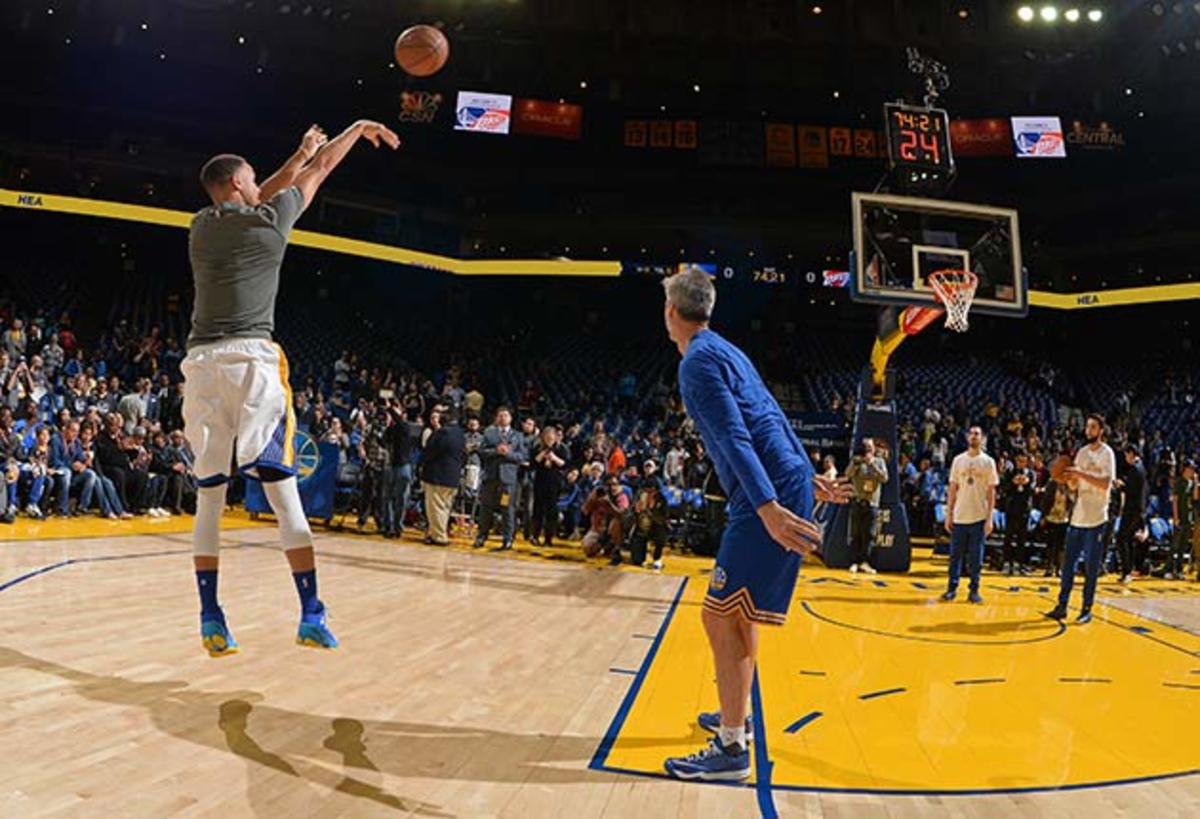
This is where Fraser comes in. Over the last two years no one has spent more time shooting with Curry than the 51-year-old Fraser, who you may recognize from broadcasts as that guy on the Warriors bench with the gray beard and perfect hair who bears an eerie resemblance to a younger version of the Most Interesting Man in the World. Before every game and after every practice and shootaround, Fraser fires one-handed push passes into Steph’s shooting pocket—just above the midriff, right side—as the guard flits around the court.
Fraser is both an unusual and ideal candidate to be Curry’s shooting guru. The son of a coach, he grew up in Long Beach and, after playing under his father for a season at Long Beach City College, went to Arizona. But after a lifetime of being a knock-down shooter, Fraser lost his confidence. His free throw percentage dropped precipitously. By the end of his junior season, Fraser had gone full Bogut; in 96 career minutes as a reserve he’d attempted only two shots. Both were off offensive rebounds. Then again, as Fraser notes, the guy playing ahead of him was Steve Kerr, who remains the alltime leader in three-point percentage in NBA history (though Steph is closing in). The two hit it off from the start, Kerr the sarcastic, likeable son of a diplomat and Fraser the laid-back point guard who asked so many questions that Kerr dubbed him Question Man, later shortened to Q-Man and, eventually, just “Q,” which he still answers to. The two played pickup ball in the summers, Q feeding Steve on the wing. While Kerr headed to the NBA, Fraser headed into coaching, working as a grad assistant under Lute Olson at Arizona, then under Larry Brown with the Pacers and Quin Snyder at Missouri and, for a while, in marketing at Oakley. When Kerr joined the Phoenix Suns as part of the ownership group in 2004, he brought Fraser on board (in 2007, when Kerr became the Phoenix GM).
During six seasons as a scout in Phoenix, Fraser also became Steve Nash’s workout partner and personal coach. When Kerr accepted the job in Golden State, in 2014, he called his old friend again. Fraser’s new assignment: Curry.
Fraser knew better than to show up dispensing advice. As he says, “Why overcoach or be the know-it-all when he’s the best in the world?”
This is Fraser’s default manner: I’m just here, doing what I can to help. Still, he has worked with four of the game’s best shooters in Kerr, Reggie Miller, Nash and Curry. He’s seen a lot of greatness.
*****
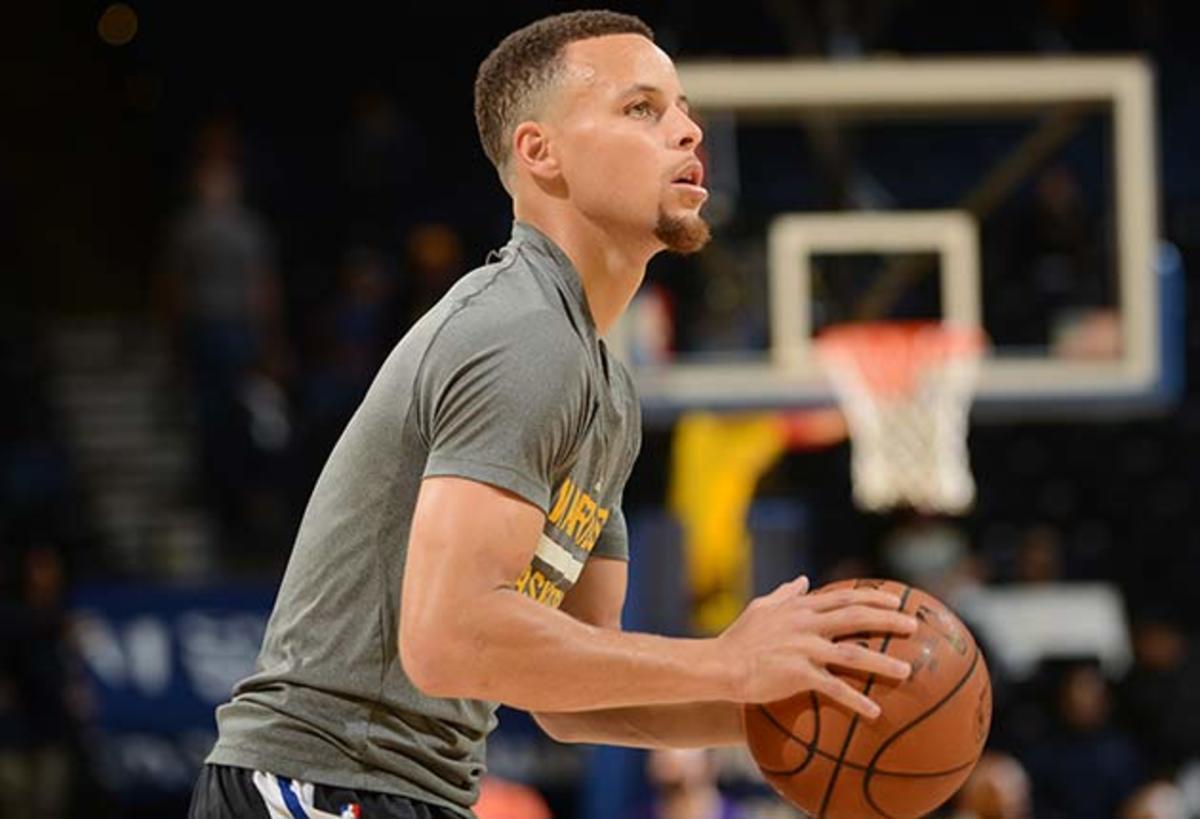
“RAAAHHH!”
This is Curry, sprinting out of the locker room and down the hallway of Oracle Arena at 6:14 PM last Saturday night before a game against Phoenix. Team staffers clear a path. A cameraman tries to keep pace and nearly topples over.
Once on the court, Curry jogs to where Fraser stands, by the far basket. A row of excited fans wait courtside—a mix of season–ticket holders and other lucky souls wearing special credentials to watch the pregame Steph show. As security shoos interloper fans away from the court, Curry begins his now-familiar routine: a series of shots ranging from scoop layups to stepback threes, taken from 17-19 spots on the floor.
Watch Curry warm up over the course of a week and what stands out is how often he looks like he’s just messing around, shooting flips and lefty hooks and floaters and launching the ball nearly straight up, trying to drop it down into the basket, as if from a passing airplane. It’s a contrast from elite shooters like Dirk Nowitzki and Nash, methodical types forever trying to minimize the deviation on every shot. With Curry, the goal is rhythm above all else, Fraser forever repeating his mantra of “Let’s get you flowing.”
So, now, as the VIPs film on their phones in the front row, Curry catches and shoots and heaves and flips and, all the while, makes.
• MORE NBA: Coaching Stephen Curry, best shooter in the universe
From a purely technical standpoint, his shot is not unusual. Curry is both a one-stepper (catch, take a step and shoot) and a hopper (catch and pop up off two feet). On his release, he brings the ball up above his shooting eye—the classic “finger up the nose” approach, as Fraser calls it—sometimes appearing as if he might scrape his forehead in the process (Nash was more of a shoulder-slot shooter, and Fraser found his own release point migrated to the right while working with him). As he shoots, Curry points his feet slightly to the left, as many right-handed shooters do, and will pivot in mid-air to align them if needed. Once the shot is up, he is a “ball watcher," keeping his eyes on the flight of his shot, rather than the rim. Kerr, Miller and Nash were also ball watchers, and Fraser believes nearly all the best shooters are.
Most notably, rather than shooting once he’s reached the peak of his jump like, say, Ray Allen, Curry shoots as he jumps, releasing just before the peak (technically, Fraser calls it “the front end of his peak”, whereas Allen shoots it on the back end of his peak, “almost as he’s coming down.”). Theoretically, this is dangerous—defenders should have an easier time blocking a lower release. Only, on account of Curry’s crazyfast release and dribbling jukes, they don’t. He has yet to have a three-pointer blocked this season.
Curry’s unique range comes from his leg push. Fraser compares Steph to an unimposing golfer who can crush the ball off the tee (notably, Steph, an excellent golfer, can crush it off the tee). Lower body strength has long been a fixation of Steph’s. When I interviewed him in 2011, he yearned to have the tree trunk legs of Ben Gordon. And in 2013, he told me that when he misses it means he’s not using his legs. “I’m fatigued a little bit, you forget to get your base down, a little lazy,” he said. “Once you get your legs into it, I think from the waist up, every time I shoot it's the same thing.” These days, he looks back on the Gordon comment with nostalgia. Says Curry: “I’ve come a long way for sure.” Still, when he does have an off shooting night—as in a recent loss to the Lakers—a familiar culprit is to blame. “That wasn’t anything but his legs,” says Fraser. “He was tired and didn’t get the lift, so he shot with his arms.”
*****
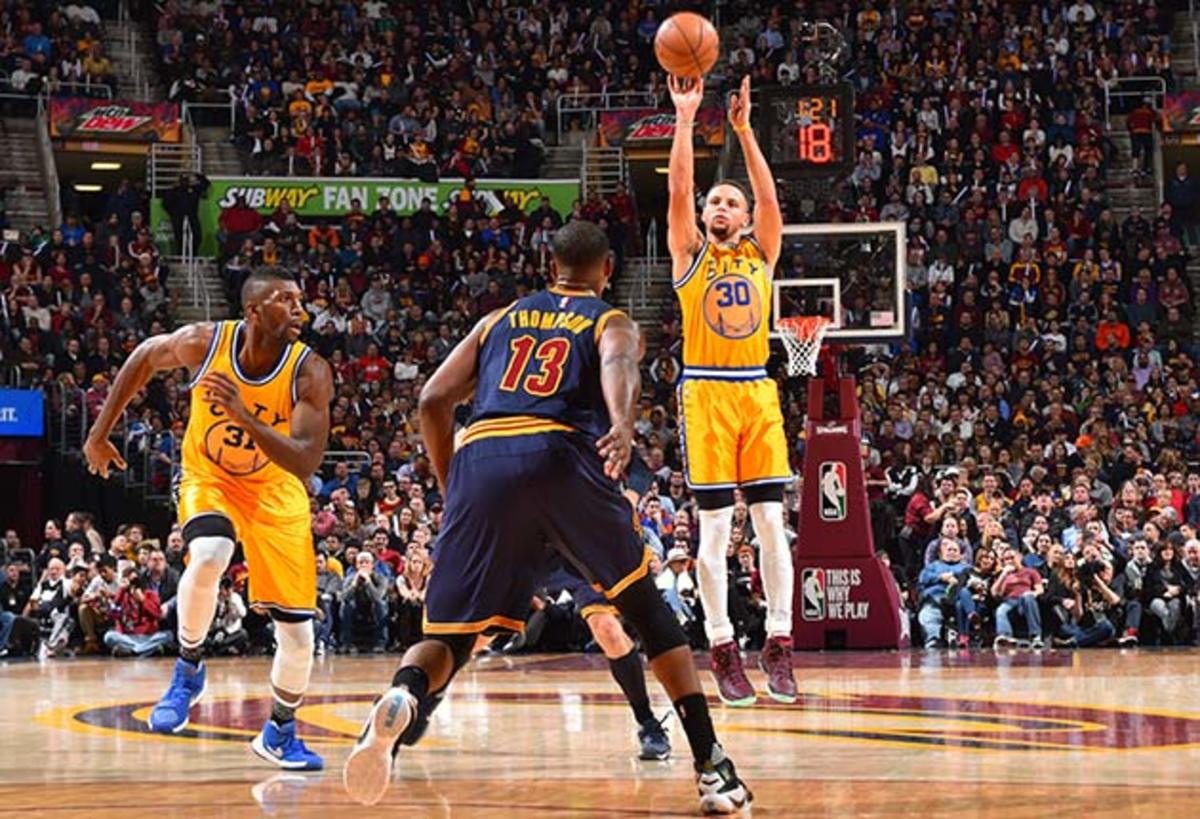
None of Curry’s approach, it should be noted, is overly complicated. You could study video of Curry and easily mimic his shot. “Should someone try and shoot like Steph?” says Fraser. “Yes. Can they? No. Could they get close? Yeah. Could someone copy the exact motion? Yeah, someone that’s really good at impersonation could, but would they make the shots? No way.
"I think everyone is wired differently and their genetic makeup is different. Some people see the flight of the ball going through the basket, that's just the way they’re wired. Some people shoot a really flat ball, some have trouble adjusting the arc of it. Steph has the ability to raise and lower arc pretty easily. Some don’t. Is that because they practice it? I think it’s more of a wiring, but that’s my own personal opinion.”
Occasionally, Fraser will tell Curry what he notices—his shot is flat, or his balance is off or his arm gets a little too far forward on his release, as it did earlier this season. “I may not be the expert on what the perfect shot is, but I know what's different about his shot when I see it,” explains Fraser. It helps that he’s already worked with one of the few players whose hand-eye coordination is akin to Steph’s. This is part of why Kerr wanted his old friend on board. “The Steph-Nash comparison is a really good one, in a lot of ways,” Kerr says before the Phoenix game. “I think a lot of Q’s work with Nash has translated to Steph.”
• MORE NBA: 2016 NBA Mock Draft 1.0: Pre-tournament projections
Indeed, Nash is another hand-eye outlier—Kerr and Fraser refer to it as the “ball and stick theory” in that you could make up any game involving a ball and stick and certain people would excel. As good as Nash is, though—dominating at ping-pong or bowling or whatever game you choose—Steph is even better. Says Fraser: “I would say he has the best hand-eye of anyone in the world.”
Sadly, Steph’s magic does not rub off. Neither Fraser nor Nick U’Ren, the Warriors assistant who also works with Curry, say the experience has improved their own shot. “I think I’ve learned what makes Steph a good shooter more so than what I could teach someone else,” says U’Ren. “The minute adjustments from one shot to the next, the muscle memory. When I shoot, I do try to remember it and I feel like I know why I’m missing…” He laughs. “But I don’t make more.”
The same goes for other Warriors. If anything, playing with Curry can have the opposite effect. “Sometimes guys end up standing around, especially guys like Harrison (Barnes), waiting for Steph to bail them out,” says Jim Barnett, longtime Warriors color analyst. Indeed, to be Steph’s teammate is to at times lapse into reverence. When Andre Iguodala joined the Warriors, he referred to Steph as, “the second coming of Jesus.” Bogut and Draymond Green can regularly be seen celebrating Curry threes before he’s even shot them.
Kerr takes a more holistic approach. No, he says, you can’t expect teammates to become good shooters merely by proximity, but that’s missing the point. “It’s hard to say there’s a tangible thing you can point to, but it’s everything,” Kerr says. “When your best player is working day after day diligently, and totally accepting criticism from the coaching staff….it just sets a tone for everybody.” In this sense, Kerr compares Curry to one of his own former teammates. “Steph is so much like Tim Duncan—quiet, confident, humble but arrogant at the same time. Arrogant on the floor and humble in every other way.”
*****
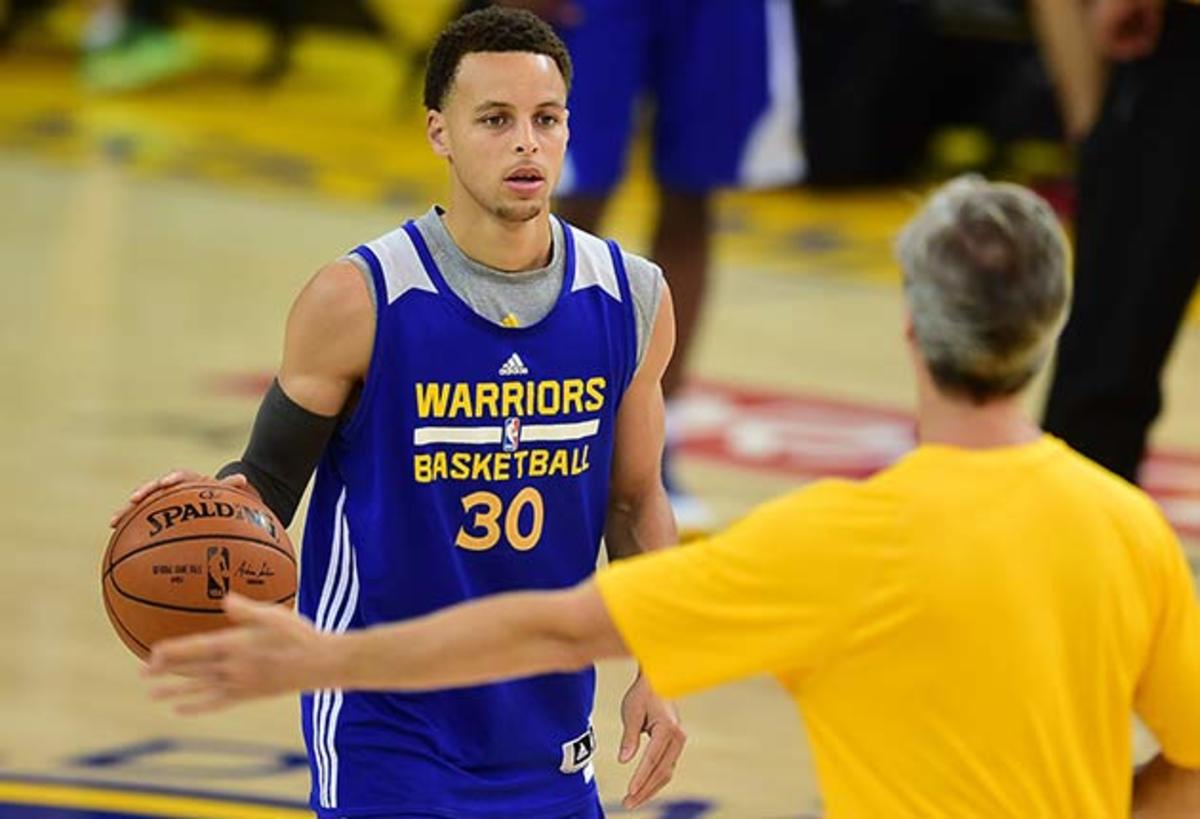
Now it is team shootaround, a day earlier, before a game against the Blazers. U’Ren stands under the basket, shagging and feeding Fraser, who in turn feeds Curry, eschewing a traditional two-hand chest pass for a one-hand push pass despite that the tendonitis that it sometimes flares in Fraser’s elbow. To Fraser, the pain is worth what he believes is improved accuracy. The goal in the practice routine is two–fold: improvement and challenge. Steph takes his usual 100 three-pointers, as he has for years, but Fraser now looks to add or tweak elements. Earlier this season, for example, he noticed that Steph's handle was “a little bit less tight”—in particular at the end of a game against the Nuggets, when Curry lost the ball in an iso against Danilo Gallinari. So they added more ballhandling to the mix.
Fraser has also adjusted the work as Curry has taken deeper and deeper shots, often with higher degrees of difficulty. Which brings us to something called Beat the Ogre. It’s a variation on an old basketball drill called Beat the Pro, which Kerr and Fraser used to play at Arizona. The game is simple: Shoot a series of shots from wherever you like—threes, midrange, wherever. Every make is one point. Every miss is negative two. Reach seven before you hit negative seven and you beat the pro (so named because you can envision playing “against” an imaginary opponent like, say, Steph Curry). As this reporter can attest, it’s a challenging and addictive game, especially if you extend the range.
• MORE NBA: Chris Ballard: The evolution of Steph Curry
Because Curry is Curry, however, Fraser had to up the ante. So in Beat the Ogre—the name derives from a joking nickname for the “meathead” Warriors strength and conditioning staff—Curry takes NBA threes on the move, plays to 21 and every miss counts for negative four, rather than two. To succeed, Curry has to be numbingly accurate: Make 10 in a row but miss two and he’s only at +2. How does he fare? “On average he does it on the second try,” says U’Ren.
Then there’s the Roll Out, a practice crowd-pleaser. To prep Steph for game situations, he regularly has to make 21 “rhythm shots” that mimic the Warriors' offense—off a side pick–and–roll or a dribble hand–off or a fade to the corner. Recently, after Steph made his 20th, Fraser whispered a plan to U’Ren. Then he rolled the ball far behind the three point line and both men followed it, converging on Steph like a grown-up version of steal the bacon. Always game, Steph snatched it and launched a crazy heave over the double team. It’s now a regular part of the routine; the final shot Steph must hit to move on. Sometimes his attempts come up far short, as at a recent practice, when Curry’s airball ended up bouncing into Steve Kerr’s lap as he talked to reporters behind the basket (and happened to be, at that moment, complimenting Curry’s shooting prowess).
Watching the drill, you might surmise that perhaps this is practice for those crazy late–game situations, or some next–level reaction drill. Fraser laughs when asked about it. “Is it helping Steph? Yeah, probably. Was the concept of it to make him take a tough shot? No, the concept was for Nick and I to have fun.” Says U’Ren: “It’s to get Steph laughing. The shots he shoots are ridiculous. I’d be lying if I said we did it to simulate an end of the game.”
You want to believe the men. And then, Friday night against the Blazers, you watch Steph pick up a ball low to the floor and flick it up. Swish. And then, at another point, he chases down an errant dribble and, without changing momentum, tosses up a three and sinks it.
*****
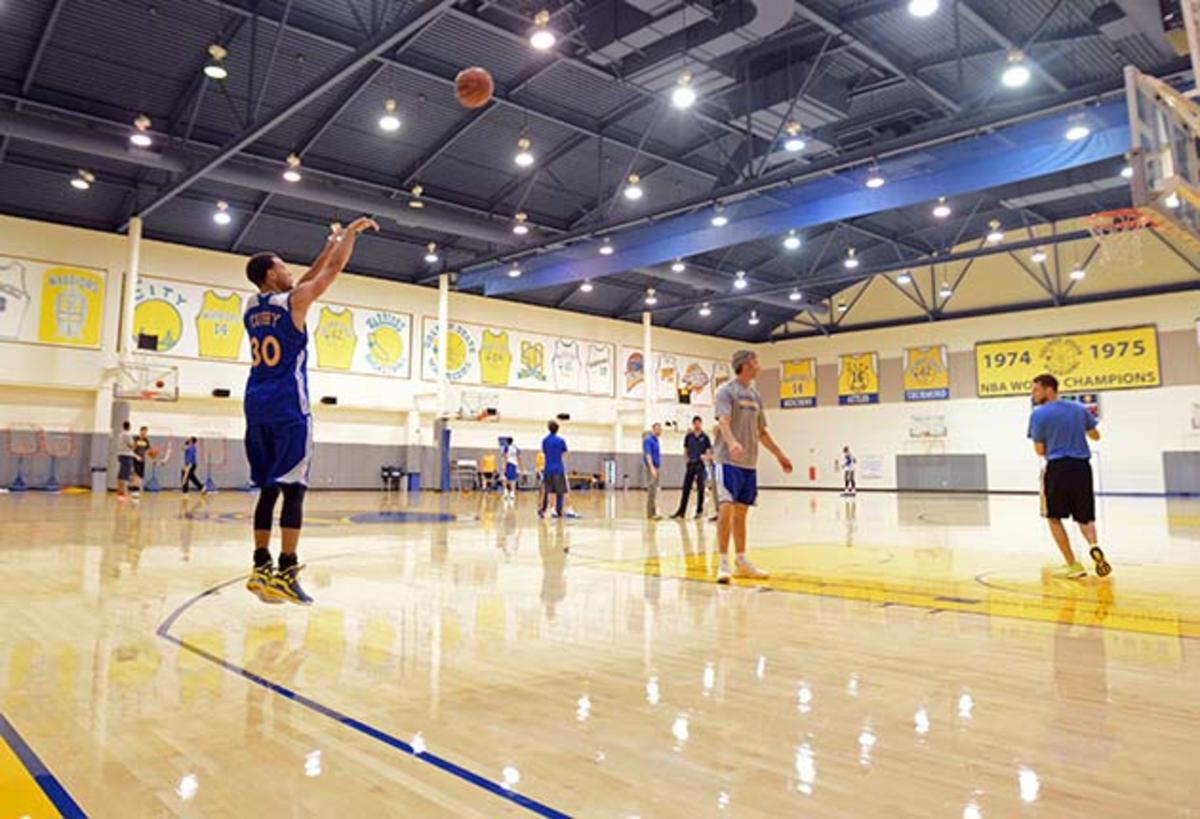
So how can you shoot like Steph? Perhaps, Fraser suggests, the key isn’t to imitate his form, but instead hone your own. “Kerr’s shot is different than Steph’s, and Nash’s is different than those two and Reggie’s is different, so which one’s better?” Fraser pauses, shrugs. “If you put Nash, Kerr, Reggie and Steph in just a catch–and–shoot game, it’d be a very close game. If you put them all at the three–point line and you had them shoot 100 shots, it would be very close. Now, who has the best form? I don’t know. They’re all great shooters. Who decides what’s the best form?”
A few years ago, Dell Curry told me he thought Steph’s success was 25% nature and 75% nurture. And Steph does work as hard as anyone in the league. Still, realistically, the average American could devote 12 hours a day to shooting jumpers for 20 years and not come close to Steph’s prowess. This is why Fraser sprints away from credit for the work he’s done. “Did you see the guy at Davidson?” he says. “He was a phenomenal shooter.”
He sure was. But, more important, he’s better now. So perhaps the way to be like Steph is to forget about form and instead mimic Steph Curry, the person. Be humble, yet arrogant. Find your flow. Be open to advice. Practice relentlessly. Never be satisfied. And, always, enjoy the process.
